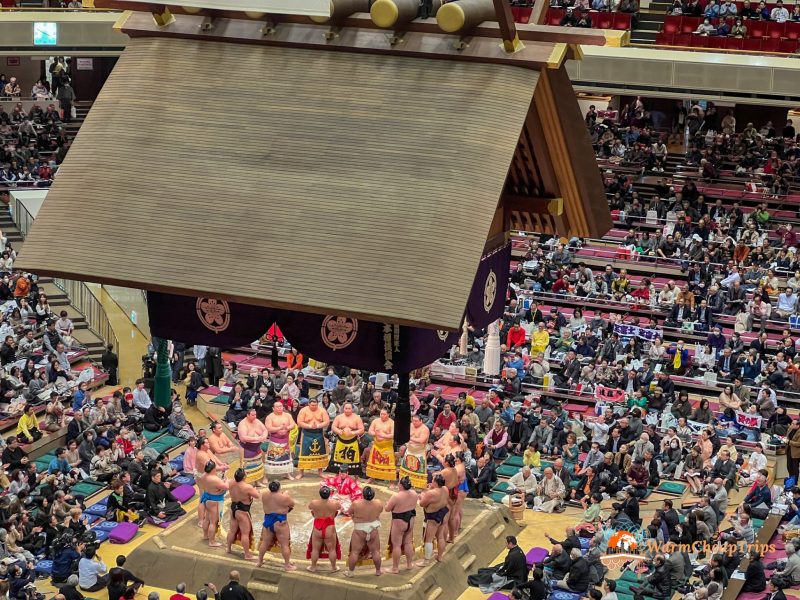Watching sumo in Japan is one of the activities that create more interest among tourists visiting Japan. Not only because they have a great interest in the sport itself, but because is one of the icons of Japan, an experience that only here can be done and that is deeply related with Japanese tradition.
With tea ceremony and wearing a kimono, sumo is one of the most famous Japanese traditions, but unlike the first two, it is not so easy to have a direct experience.
By one side it is because Sumo is a bit like the world of Geisha, a “caste” whose members are people who since childhood decided to take this path, living a particular life, by other hand because, being a sport, it follows a calendar of events that requires the wrestlers to move around Japan following the dates of the Great Sumo Tournament and other national competitions.
But don’t, worry, in different style is almost always possible to see some Sumo in Tokyo!
Watching Sumo in Tokyo
In Tokyo 3 of the 6 Great Sumo Tournaments are held, so for 6 weeks a year you have the chance to watch the Sumo official matches, including the Yokuzuna matches and other top-level fighters. But also in the other time of the year there are many wrestling stable where you can attend training especially in the Ryogoku district and surrounding area ot restaurant where you can see a show of former wrestlers.
Sumo is national sport in Japan and its rituals and gestures are deeply related to Shinto and to the purification rituals and prayer for a good harvest. Only in the Samurai period began to be practiced as a martial art and in the seventeenth century the wrestlers became professionals and thus began the Great Sumo Tournament as we know today.


Great Sumo Tournement
Attending the Great Sumo Tournament is absolutely the best experience to watch Sumo in Tokyo, but this opportunity can only be achieved three times a year for two weeks each time.
The month in which the event is held in Tokyo, at Ryogoku Kokugikan are January, May and September, while in March, July and November it takes place in Osaka, Nagoya and Fukuoka.
The meetings are everyday and start from 8.30 in the morning until about 18.00 and the daily ticket allows you to re-entry in the stadium only once during the day. In the morning there are bouts of the lower category Sumo wrestler, while after lunch break begins the intermediate division, called Juryo, followed by the highest levels, whose entry takes place around 15.30, followed by the entrance and the solemn presentation of the Yokozuna, the highest level reached by a Sumo wrestler obtained after a series of victories, considered almost a semi-deity. In recent years, unfortunately, the number of almost unbeaten Japanese fighters has dropped, in favor of the strong Mongol wrestlers, so at the moment, after years of absence, there is only one Japanese Yokozuna, Kisenosato.
Tickets to attend Sumo Tournament went on sale on the official website in English about two months before (exact dates on the website), but they run out very quickly, almost always still on the first hour of sales. The stadium is divided into two areas, the lower area of the arena, closer to the ring and with the boxes to sit in Japanese style (on the ground) and prices range from 10.000 yen to 20.000yen for seats near the ring.
On the second floor are the normal armchairs, whose prices range from 4.500yen to 9.500yen.
If you absolutely want to attend the tournament but couldn’t get tickets, don’t despair! You can still join a guided tour—an option that is certainly more expensive, but one that could be an excellent choice if you’d like to dive deeper into the history of Sumo and better understand what you’re watching. Keep in mind, though, that these tours also need to be booked as early as possible and are usually made available about two months before the tournament dates.


Morning Training of Sumo Wrestler
If you visit Tokyo not during the Gret Sumo Tournament, you can still watch Sumo. Usually the training of wrestlers takes place in the morning, from 7.30 and continue for a couple of hours. Some stable have windows on the street where you can look in at the training, without reservation, like the Arashio-Beya stable.
Other stables admit a limited number of visitors, but telephone booking in japanese is generally required and they prefer a Japanese person come with you.
Otherwise, I recommend the morning Sumo training experience, which I personally tried at the Isegahama-Beya, whose oyakata is Terunofuji, the Yokozuna who retired at the beginning of 2025. Beyond the great thrill of seeing the Yokozuna, the added value of this specific tour is that you’ll be given an earpiece to listen to the guide’s explanations. They not only share history and curiosities about sumo but also provide live commentary on what’s happening during the training session. This stable is located in Sumida Ward, precisely in Ryogoku, which is known as the sumo district.
During training, you cannot talk or move around, and photos are allowed but not videos.
The stable is quite small, and visitors sit on a low bench very close to the wrestlers. A sumo training session includes stretching, basic exercises, and sparring matches. The stable’s President (Oyakata) oversees the entire practice, and the wrestlers themselves address him with reverence. It was definitely an interesting experience to discover the world of sumo stables, and at the end, you can even take a commemorative photo with the wrestlers.


Ex-Sumo wrestler show
Last option to watch Sumo in Tokyo, which is not even subject to the sumo tournament schedule, is to see some amateur or former sumo wrestlers show. In some restaurants, like Yokozuna Tonkatsu Dozei Tanaka, there is actually an opportunity to have lunch with Chanko Nabe, the wrestlers’ dish par excellence, and witness Sumo technique demonstrations by ex-wrestlers. I had the chance to take part in one of these experiences and I highly recommend it, even more than the morning training!
During this show, the various moves and rules of Sumo are explained in English, and participants are allowed to take photos and videos. It is also a less formal environment than the gym, so you can chat and ask questions at the end. This experience truly allows you to appreciate Sumo, even if you have no prior knowledge of the sport, and the combination with lunch is perfect.
The Sumo show with lunch is not available every day and must be booked in advance. It costs around a hundred euros per person. In addition to the aforementioned restaurant, which has limited dates, I recommend checking out the experience offered by GetYourGuide.
About a year ago the Sumo Asakusa Club opened in Asakusa, offering meals with a show two or three times a day, depending on the season. In theory, you can also just show up at 12:00 or 18:00 and usually find a spot on weekdays, but I imagine that as time goes by it will become more popular, so I recommend booking in advance.
I personally attended this show and had a great time! The host speaks English, explains everything very clearly, and really knows how to engage the audience. The performance is fascinating: while you eat, there’s an introduction to the history and symbolism of sumo, followed by a short performance by a real geisha. Then the cheerful wrestlers come on stage and demonstrate the main movements, training routines, and fighting techniques, before the final bout.
The whole experience is lively and fun, and children in particular receive special attention—but adults loved it too! Guests can even take part in the optional final match against the wrestlers.
At the end, there’s time for questions and commemorative photos, which are even printed and given to you along with some small souvenirs. Compared to a tournament or practice session, this experience is much less formal and makes sumo enjoyable even for those who don’t know anything about the sport, as well as for kids. Pairing it with a meal is an excellent idea too—especially since the food is all you can eat, and you can order extra ingredients for the chanko nabe directly from your smartphone.


Did you find this article useful? Buy me a coffee 🙂



